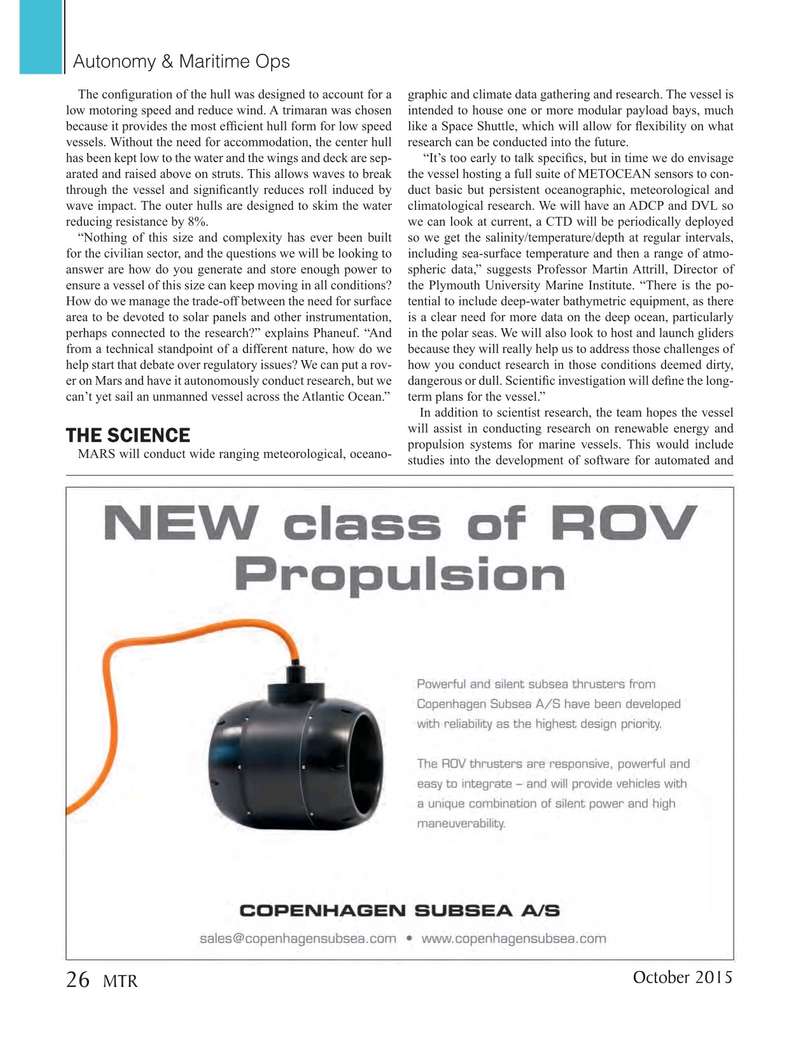
Page 26: of Marine Technology Magazine (October 2015)
AUV Operations
Read this page in Pdf, Flash or Html5 edition of October 2015 Marine Technology Magazine
Autonomy & Maritime Ops
The con? guration of the hull was designed to account for a graphic and climate data gathering and research. The vessel is low motoring speed and reduce wind. A trimaran was chosen intended to house one or more modular payload bays, much because it provides the most ef? cient hull form for low speed like a Space Shuttle, which will allow for ? exibility on what vessels. Without the need for accommodation, the center hull research can be conducted into the future.
has been kept low to the water and the wings and deck are sep- “It’s too early to talk speci? cs, but in time we do envisage arated and raised above on struts. This allows waves to break the vessel hosting a full suite of METOCEAN sensors to con- through the vessel and signi? cantly reduces roll induced by duct basic but persistent oceanographic, meteorological and wave impact. The outer hulls are designed to skim the water climatological research. We will have an ADCP and DVL so reducing resistance by 8%. we can look at current, a CTD will be periodically deployed “Nothing of this size and complexity has ever been built so we get the salinity/temperature/depth at regular intervals, for the civilian sector, and the questions we will be looking to including sea-surface temperature and then a range of atmo- answer are how do you generate and store enough power to spheric data,” suggests Professor Martin Attrill, Director of ensure a vessel of this size can keep moving in all conditions? the Plymouth University Marine Institute. “There is the po-
How do we manage the trade-off between the need for surface tential to include deep-water bathymetric equipment, as there area to be devoted to solar panels and other instrumentation, is a clear need for more data on the deep ocean, particularly perhaps connected to the research?” explains Phaneuf. “And in the polar seas. We will also look to host and launch gliders from a technical standpoint of a different nature, how do we because they will really help us to address those challenges of help start that debate over regulatory issues? We can put a rov- how you conduct research in those conditions deemed dirty, er on Mars and have it autonomously conduct research, but we dangerous or dull. Scienti? c investigation will de? ne the long- can’t yet sail an unmanned vessel across the Atlantic Ocean.” term plans for the vessel.”
In addition to scientist research, the team hopes the vessel will assist in conducting research on renewable energy and
THE SCIENCE propulsion systems for marine vessels. This would include
MARS will conduct wide ranging meteorological, oceano- studies into the development of software for automated and
October 2015 26 MTR
MTR #8 (18-33).indd 26 10/1/2015 12:10:31 PM

 25
25

 27
27
